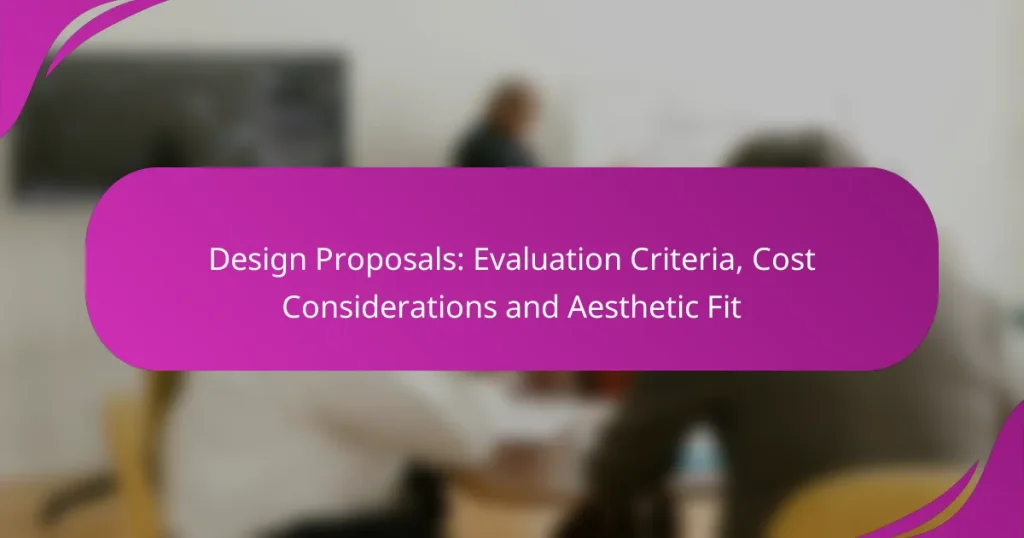When evaluating design proposals, it is essential to consider key criteria such as functionality, cost, aesthetics, compliance, and timeline. These factors ensure that the design aligns with project goals while remaining within budget and regulatory limits. Additionally, assessing cost considerations and aesthetic fit is crucial for making informed decisions that resonate with the brand’s identity and target audience.
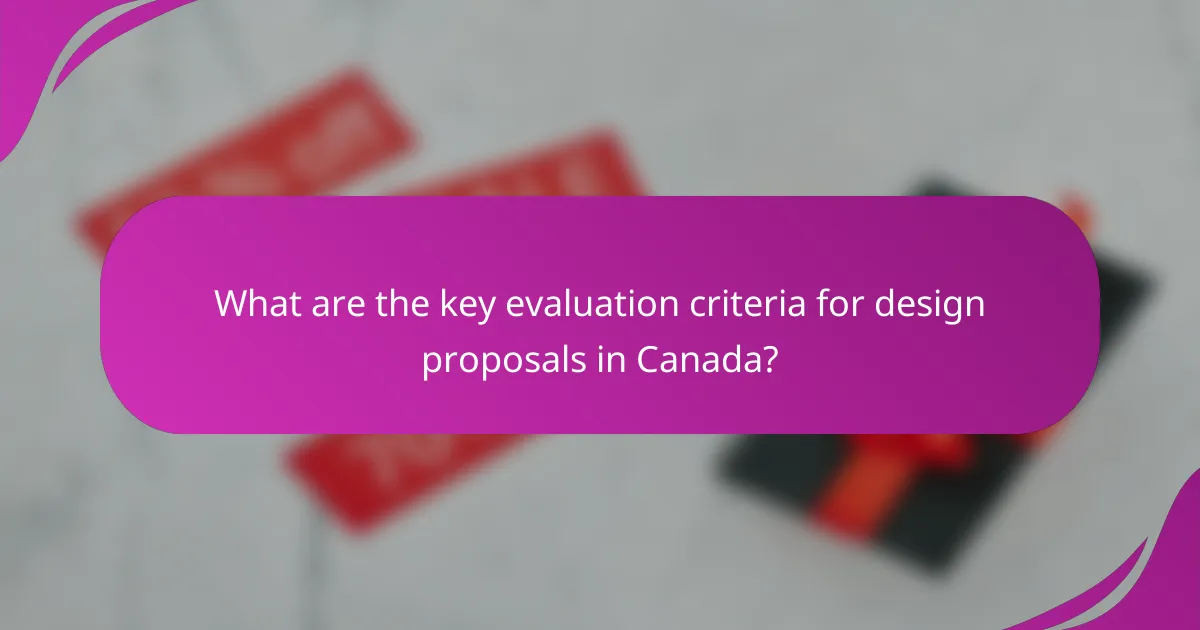
What are the key evaluation criteria for design proposals in Canada?
The key evaluation criteria for design proposals in Canada focus on functionality, cost, aesthetics, compliance, and timeline. These factors help ensure that the final design meets the project’s goals while adhering to budgetary and regulatory constraints.
Functionality and usability
Functionality and usability are critical in assessing design proposals. A design must effectively serve its intended purpose and be easy for users to navigate. Consider conducting usability tests or gathering user feedback to evaluate how well the design meets these criteria.
When reviewing proposals, look for features that enhance user experience, such as intuitive layouts and accessible design elements. Ensure that the design accommodates various user needs, including those with disabilities.
Cost-effectiveness
Cost-effectiveness evaluates whether a design proposal delivers value within budget constraints. This includes not only the initial costs but also long-term maintenance and operational expenses. Proposals should provide a clear breakdown of costs to facilitate comparison.
Consider using a cost-benefit analysis to weigh the financial implications of each proposal. A design that may seem more expensive upfront might offer savings in the long run through durability or lower maintenance needs.
Aesthetic alignment with brand
Aesthetic alignment with brand ensures that the design reflects the organization’s identity and values. The proposal should incorporate brand colors, logos, and overall style to create a cohesive image. This alignment helps strengthen brand recognition and loyalty among customers.
Review past design materials and guidelines to ensure consistency. A well-aligned design not only attracts attention but also fosters trust and familiarity with the brand.
Compliance with local regulations
Compliance with local regulations is essential for any design proposal in Canada. This includes adherence to zoning laws, building codes, and accessibility standards. Non-compliance can lead to costly delays or redesigns, making this a critical evaluation factor.
Familiarize yourself with relevant regulations in your area, such as the Canadian Standards Association (CSA) guidelines. Ensure that proposals include documentation demonstrating compliance to avoid potential legal issues.
Timeline feasibility
Timeline feasibility assesses whether the proposed design can be completed within the project’s schedule. A realistic timeline is crucial for project success, as delays can impact budgets and stakeholder satisfaction. Review each proposal’s timeline and milestones carefully.
Consider factors such as resource availability and potential bottlenecks. Proposals should include contingency plans to address unforeseen delays, ensuring that the project remains on track.
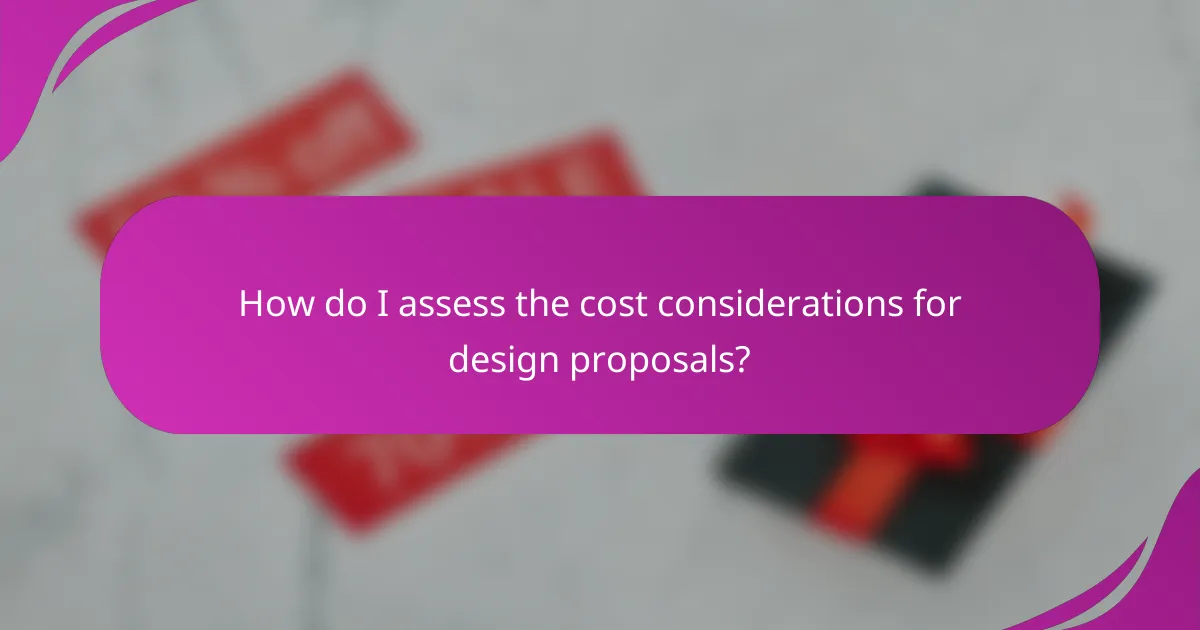
How do I assess the cost considerations for design proposals?
To assess cost considerations for design proposals, evaluate the overall budget, compare local pricing, and analyze long-term value. Understanding these factors will help you make informed decisions that align with your financial constraints and project goals.
Budget breakdown analysis
A budget breakdown analysis involves itemizing all costs associated with a design proposal, including materials, labor, and overhead. This transparency allows you to identify potential areas for savings or unexpected expenses.
Consider creating a detailed table that lists each component of the budget, its estimated cost, and any contingencies. This will help you visualize the financial landscape and make adjustments as necessary.
Comparative pricing from local firms
Comparative pricing from local firms is essential for understanding the market rate for similar design services. Gather quotes from multiple providers to ensure you are getting a competitive price.
When comparing prices, consider factors such as the firm’s reputation, experience, and the quality of their previous work. This will help you determine whether a higher price may be justified by superior service or outcomes.
Long-term value assessment
A long-term value assessment evaluates the potential return on investment (ROI) of a design proposal. Consider not only the initial costs but also how the design will perform over time, including maintenance and operational efficiency.
For example, investing in higher-quality materials may lead to lower maintenance costs and longer lifespan, ultimately saving money in the long run. Weigh these factors against the upfront costs to make a balanced decision.
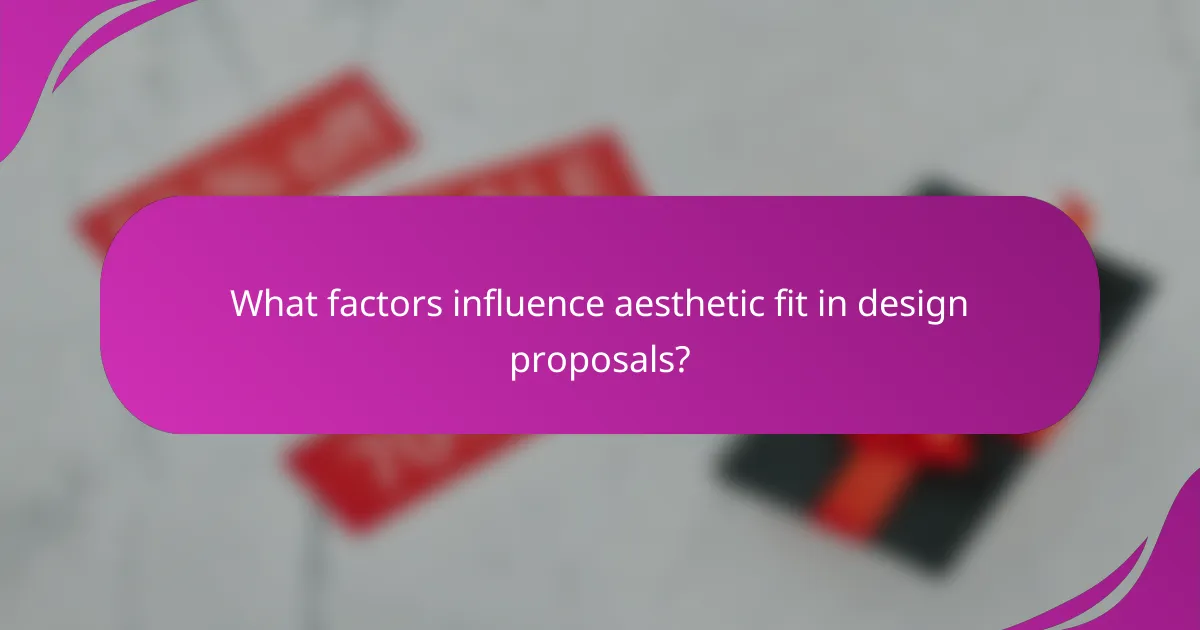
What factors influence aesthetic fit in design proposals?
Aesthetic fit in design proposals is influenced by how well the design aligns with the brand’s identity, resonates with the target audience, and adheres to current design trends. Understanding these factors ensures that the design not only looks appealing but also serves its intended purpose effectively.
Brand identity coherence
Brand identity coherence is crucial for maintaining a consistent image across all platforms. Designs should reflect the brand’s values, mission, and personality, ensuring that colors, typography, and imagery align with existing branding elements. For example, a luxury brand may favor elegant fonts and a muted color palette, while a youthful brand might opt for vibrant colors and playful graphics.
To evaluate coherence, compare the proposed design against established brand guidelines. Look for alignment in visual elements and messaging to ensure the design enhances rather than dilutes the brand’s identity.
Target audience preferences
Understanding target audience preferences is essential for creating designs that resonate. Conducting surveys or focus groups can provide insights into what styles, colors, and themes appeal to your audience. For instance, a tech-savvy demographic may prefer sleek, modern designs, while a family-oriented audience might favor warm, inviting aesthetics.
When assessing proposals, consider how well the design speaks to the audience’s tastes and expectations. A design that feels relatable and engaging can significantly enhance user experience and brand loyalty.
Current design trends in Canada
Staying updated with current design trends in Canada is vital for ensuring relevance. Trends may include minimalism, sustainability, and the use of bold typography. For example, many Canadian brands are embracing eco-friendly designs that reflect a commitment to sustainability, which resonates with environmentally conscious consumers.
To incorporate trends effectively, analyze successful local brands and their design choices. This can inform your proposals and help you avoid outdated styles that may alienate your audience. Regularly reviewing design publications and attending industry events can also provide inspiration and insight into emerging trends.
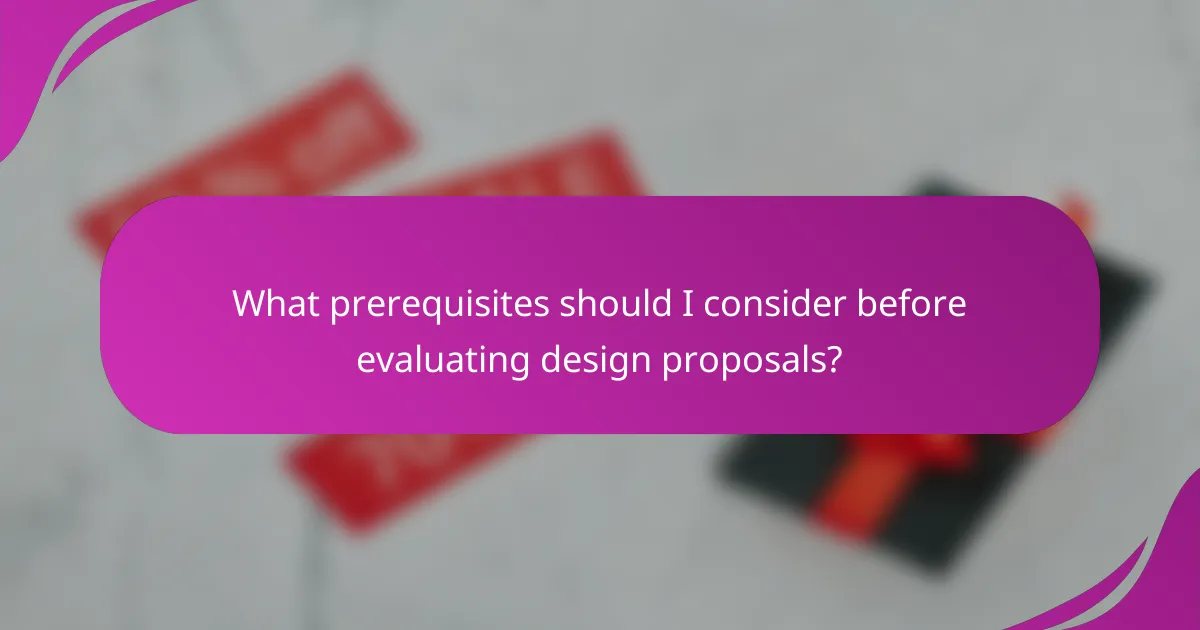
What prerequisites should I consider before evaluating design proposals?
Before evaluating design proposals, it’s essential to establish a clear framework that includes project objectives, understanding the target audience, and setting budget limits. These prerequisites ensure that proposals align with your vision and financial constraints, leading to more effective decision-making.
Clear project objectives
Defining clear project objectives is crucial for guiding the evaluation of design proposals. Objectives should outline what you aim to achieve, such as improving user engagement, enhancing brand visibility, or streamlining functionality. A well-articulated objective serves as a benchmark against which you can measure the effectiveness of each proposal.
Consider using the SMART criteria—Specific, Measurable, Achievable, Relevant, and Time-bound—to refine your objectives. For example, instead of stating “improve website design,” specify “increase website traffic by 20% within six months.” This clarity helps designers tailor their proposals to meet your needs.
Defined target audience
Understanding your defined target audience is essential for evaluating design proposals effectively. Knowing who will use the design allows you to assess whether the proposals resonate with that demographic. Factors such as age, preferences, and behaviors should inform your evaluation criteria.
For instance, if your target audience consists of young professionals, proposals that incorporate modern aesthetics and mobile-friendly features will likely be more appealing. Create user personas to visualize and articulate the characteristics of your audience, which can guide the selection process.
Established budget limits
Establishing budget limits is a fundamental prerequisite for evaluating design proposals. A clear budget helps filter out proposals that exceed your financial capacity, ensuring that you only consider feasible options. Determine a realistic budget range based on project scope and market rates for design services.
For example, if your budget for a website redesign is between $5,000 and $15,000, communicate this to potential designers. This transparency encourages proposals that align with your financial expectations and prevents misunderstandings later in the project. Avoid common pitfalls by allowing a small percentage of your budget for unexpected costs, typically around 10% to 15%.
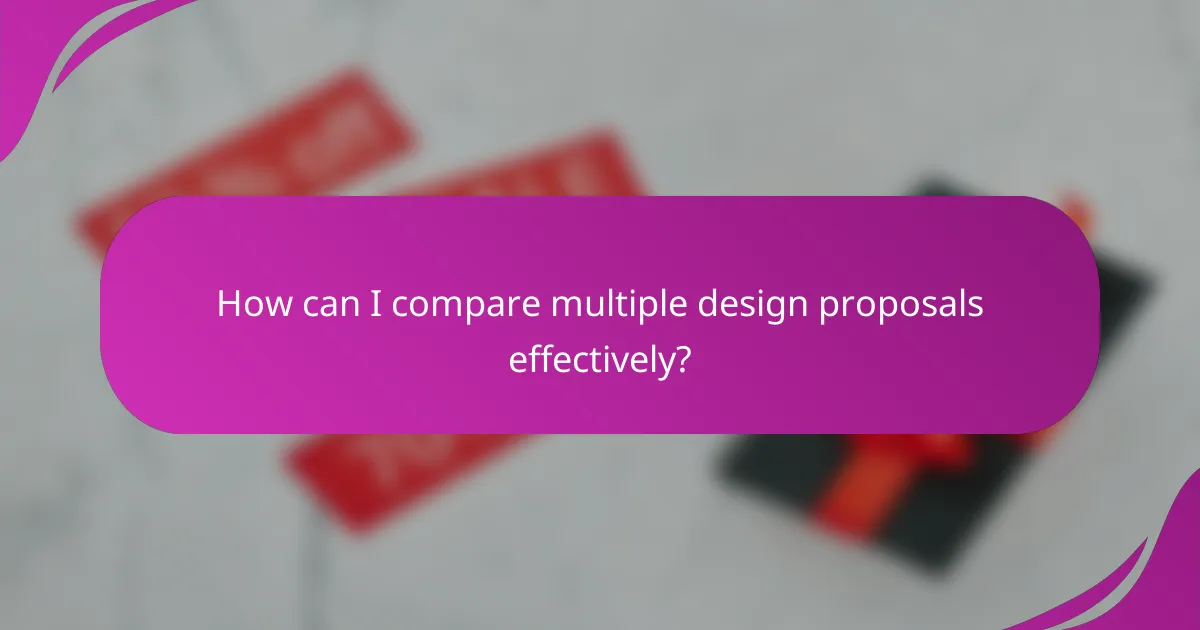
How can I compare multiple design proposals effectively?
To compare multiple design proposals effectively, establish clear criteria that reflect your project goals. Focus on evaluating aspects such as cost, functionality, and aesthetic appeal to make informed decisions.
Evaluation matrix creation
Creating an evaluation matrix involves listing all design proposals alongside key criteria. Common criteria include cost, design quality, compliance with requirements, and timeline. This visual representation helps identify strengths and weaknesses at a glance.
Start by assigning weights to each criterion based on its importance to your project. For instance, if budget is a primary concern, it might carry more weight than aesthetic fit. Rate each proposal against these criteria using a consistent scoring system, such as a scale from 1 to 5.
Once you have your scores, calculate a total for each proposal. This quantitative approach allows for straightforward comparisons, helping you to choose the design that best meets your needs while staying within budget constraints.
